Disclaimer: This post may contain Amazon affiliate links. Sudachi earns a small percentage from qualifying purchases at no extra cost to you. See disclaimer for more info.
Featured Comment:
“I made takoyaki based on this recipe. That was unbelievably tasty. By the way this is not the first recipe.”
– @k.p.6077 (from YouTube)
What is Takoyaki (Japanese Octopus Balls)?
Takoyaki (たこ焼き) is a type of Japanese street food snack. It’s a small dumpling made from a thin batter cooked in a special circular mold to become a round ball shape. “Tako” (たこ) is the Japanese word for “octopus” and “yaki” (焼き) means to fry. In other words, takoyaki is a fried octopus ball.
It often contains other ingredients, such as tenkasu (pieces of tempura batter) and benishoga (red pickled ginger), which add great taste and texture. It is then usually topped with a delicious Worcestershire sauce-based sauce, mayonnaise, aonori (dried seaweed powder), and katsuobushi (bonito flakes). No wonder every bite is a taste sensation!
Although takoyaki is most commonly found at yatai (屋台) food stands during summer festivals and events, they can be found all year round in convenience stores, supermarkets, and specialist takoyaki restaurants.


How I Developed This Recipe
A lot of people in Japan use a store-bought takoyaki flour mix when they make takoyaki at home because it’s convenient. But I can assure you that making takoyaki from scratch is much easier than you might think. In this recipe, I’ve stuck with the traditional method, starting with basic flour to make what I think is the best takoyaki you can get at home.
The results were even better than I’d hoped. The takoyaki turned out to be really tasty, with a crispy outside and a warm, gooey center that was bursting with flavor.
I’m looking forward to you trying it out and experiencing the satisfaction of making it yourself at home!
Ingredients & Substitution Ideas
- Takoyaki Sauce: Create a flavorful blend using Worcestershire sauce, tsuyu sauce (or soy sauce as an alternative), ketchup, and honey. For a convenient option, store-bought takoyaki or okonomiyaki sauce works wonderfully too!
- Dashi Stock: The key to making irresistible takoyaki is using dashi (Japanese soup stock) instead of plain water. This umami-rich base really takes the batter’s flavor profile to the next level. If you’re short on time, instant dashi granules or dashi packets are great shortcuts for this recipe.
- Eggs: Fresh eggs are essential for achieving that fluffy texture we all love in takoyaki.
- Cake Flour: This low-gluten cake flour is also called pastry flour and gives the finished takoyaki a light and tender texture. If you’re using store-bought takoyaki flour, you can skip the from-scratch batter preparation.
- Tsuyu Sauce: This versatile tsuyu sauce is great for both the dipping sauce and the batter in this recipe. If you don’t have any on hand, just use an equal amount of soy sauce plus a pinch of sugar.
- Sesame Oil: Just a little aromatic sesame oil adds a subtle nutty flavor.
- Octopus: Use pre-cooked (boiled or steamed) octopus for convenience. If you’re working with raw octopus, be sure to boil it thoroughly before adding to your takoyaki.
- Other filling ingredients: Benishoga (red pickled ginger), chopped green onions, and tenkasu (tempura flakes).
- Toppings: Finish your takoyaki with a drizzle of creamy mayonnaise, a sprinkle of aonori (dried green seaweed) powder, katsuobushi (bonito flakes), and if you want, some chopped green onions for freshness and color.
Alternative Ingredients:
As you might guess from its name, takoyaki usually contains octopus. But if you can’t find octopus where you live, don’t worry! In this section, I’ll share some tasty alternatives to fill your takoyaki.
- Shrimp – One of the closest seafood alternatives.
- Squid – One of the closest seafood alternatives.
- Sausage – This is a popular option among kids in Japan.
- Cheese – Ball-shaped processed cheese would work the best.
- Beef – Not so well-known but cubed beef steak with moderate fat content would work well!
- Mushrooms – As a vegetable alternative.
- Kimchi – A fusion dish with a completely different taste, but it is a popular option in Japan these days.
Remember that takoyaki doesn’t take long to cook so your fillings should be precooked. (The octopus in takoyaki is always pre-boiled.)
Jump to Full Recipe Measurements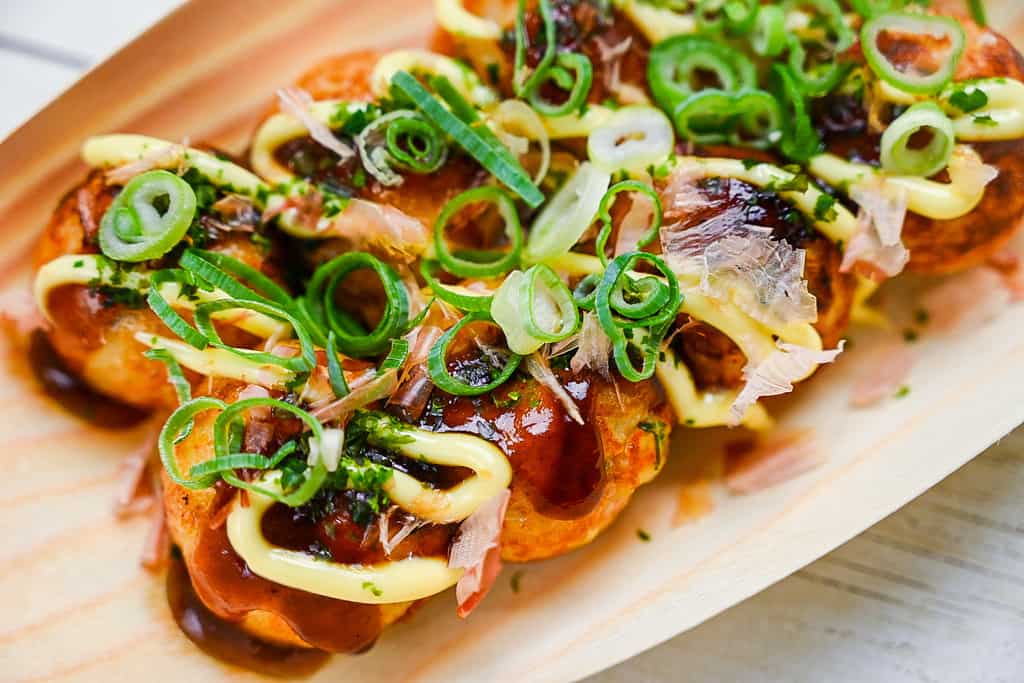
Equipment: How to Choose Takoyaki Pan/Maker
Unfortunately, you will need some specialized equipment to make takoyaki at home. The equipment in question is the “takoyaki pan” known as called takoyaki-ki (タコ焼き機) in Japanese.
A takoyaki pan is basically a cooking mold made up of small hemispherical grooves. The batter is poured into the mold and then turned occasionally with skewers to make a ball shape.
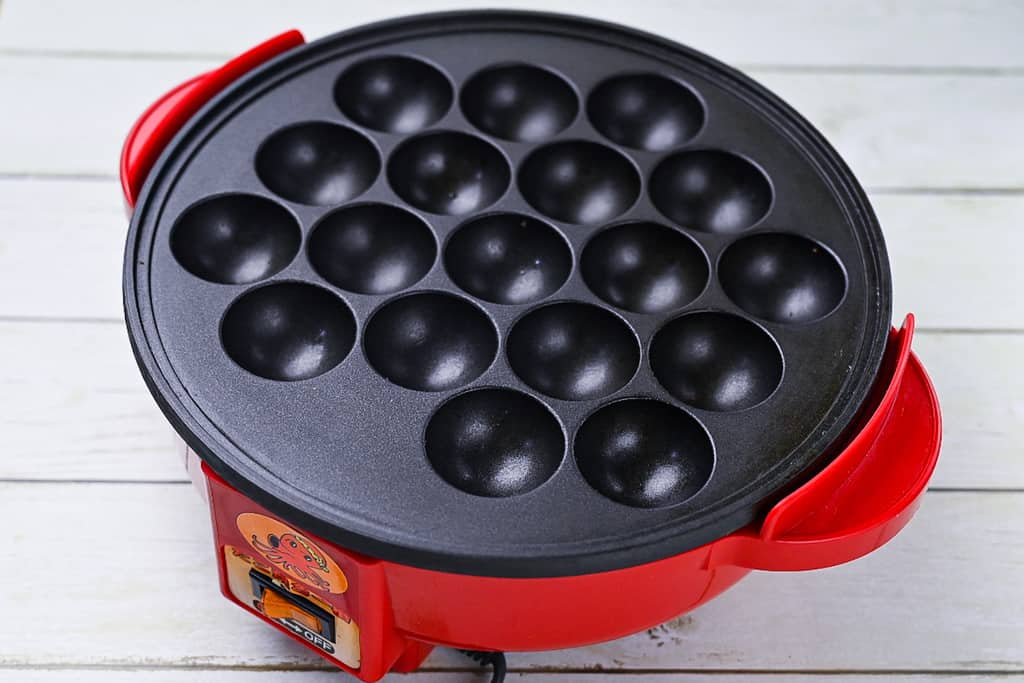
The electric takoyaki pan in the picture above is from my family home and is quite typical among Japanese families. (I don’t know the brand.) These are great for sitting in the middle of the dinner table and making a fun activity out of “takoyaki night”. These days, I personally use an Iwatani Takoyaki Grill Pan on a gas stove since it takes up less room in my kitchen and it’s easier to clean. (You could even take it camping!)
It’s not too difficult to find electric takoyaki pans online these days, just bear in mind that if you are buying electrical products from Japan, contact the seller and ask about the outlet and voltage compatibility to make sure it will work in your country.
I’ve also heard of people using Danish Aebleskiver pans, I’m not sure how big they are, but the shape looks perfect for making takoyaki.
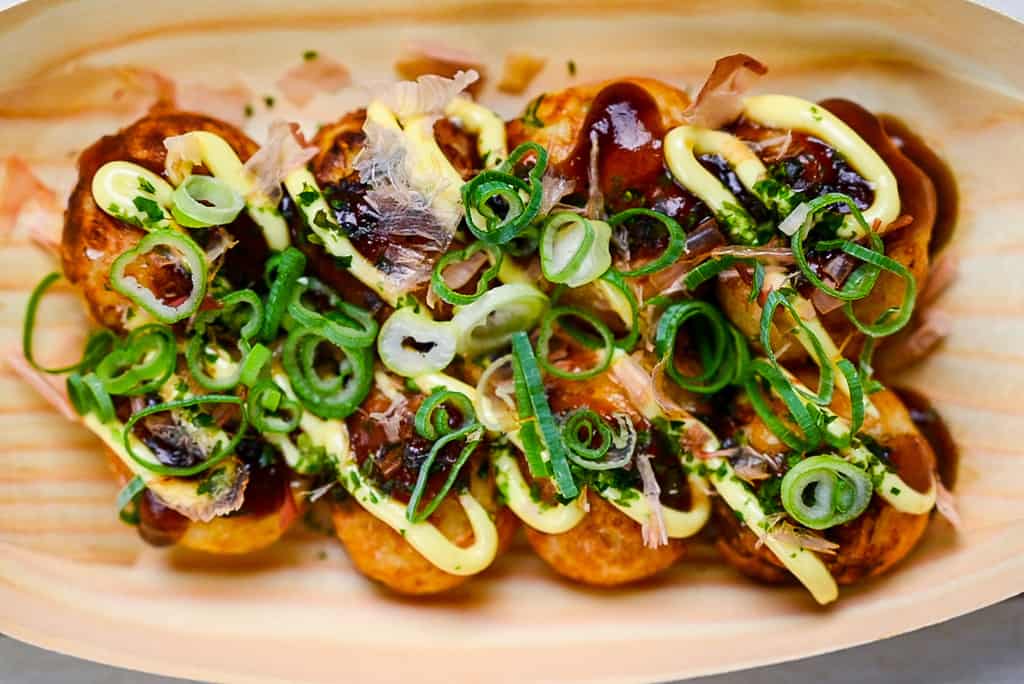
Visual Walkthrough & Tips
Here are my step-by-step instructions for how to make Takoyaki at home. For ingredient quantities and simplified instructions, scroll down for the Printable Recipe Card below.
If you prefer to watch the process in action, check out my YouTube video of this recipe for a complete visual walkthrough!
1. Prepare Ingredients & Make Batter
Mix the Worcestershire sauce, tsuyu sauce, ketchup and honey in a small bowl and set aside for later.
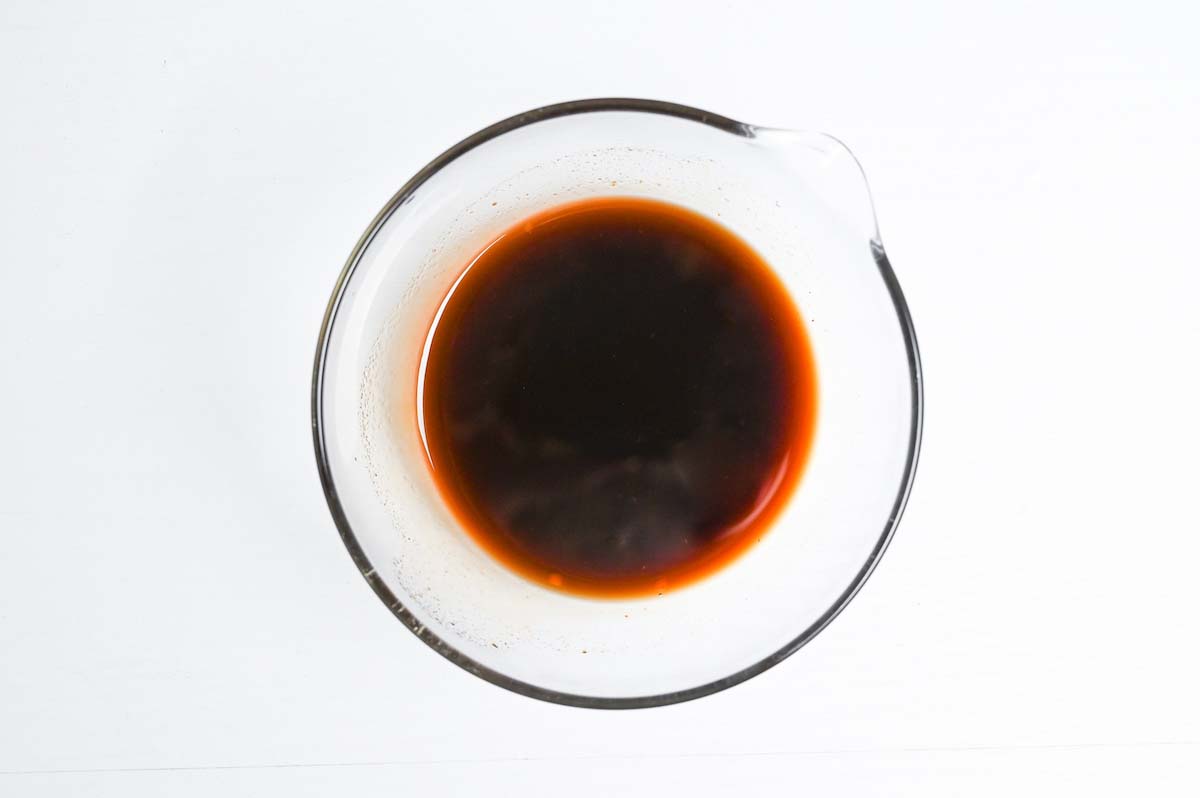
The octopus should be cut into bitesize pieces so that you can fit one in each of the grooves of the takoyaki pan. The rest of the ingredients should be finely chopped or diced so it’s easy to scatter them across the batter.
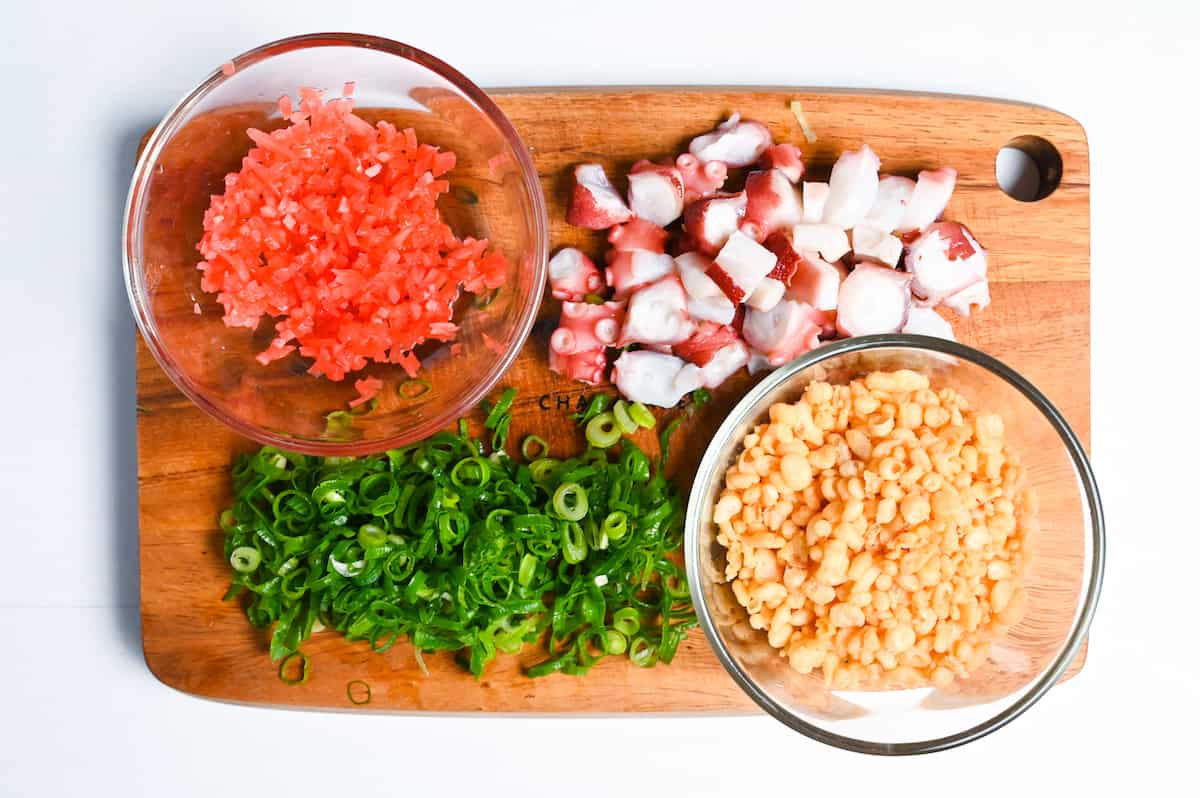
Mix the egg, tsuyu sauce and dashi together in a bowl or jug. The dashi should be cold or lukewarm at the most (not hot!) to avoid accidentally cooking the egg.
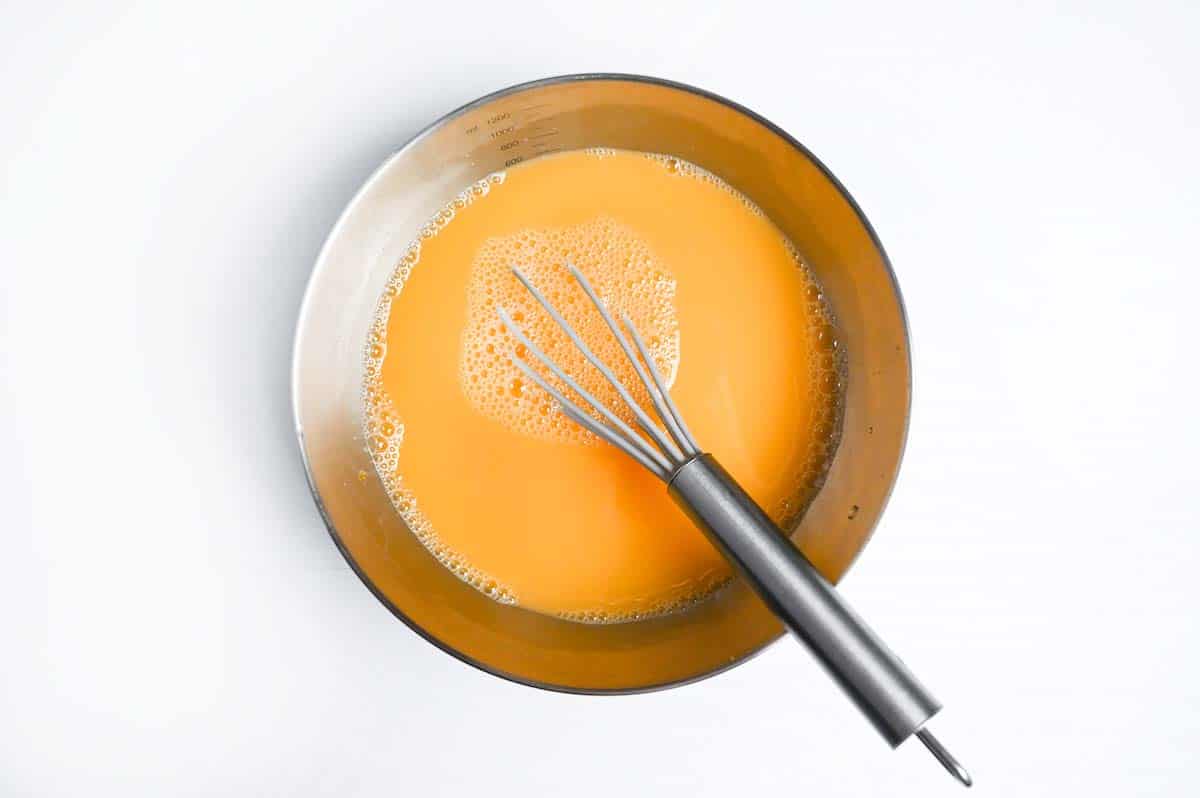
In a separate bowl, add the flour and make a well in the middle. Pour the dashi and egg mixture into the well while whisking.
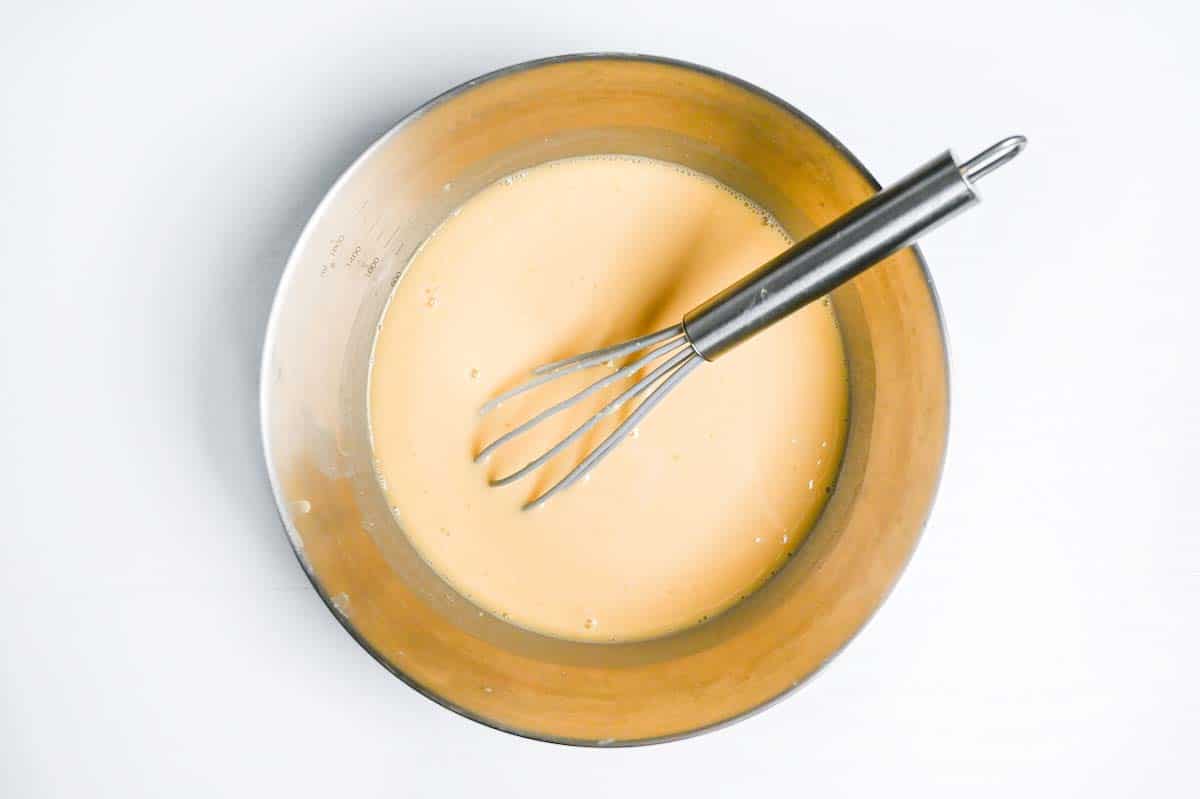
The batter should be smooth and thin; the consistency is thinner than the pancake batter and easy to pour.
2. Cook Octopus Balls in a Takoyaki Pan
Preheat the takoyaki pan on a medium heat. Once hot, pour oil generously across the top and use a brush to evenly coat each groove. This will ensure that the takoyaki doesn’t stick.
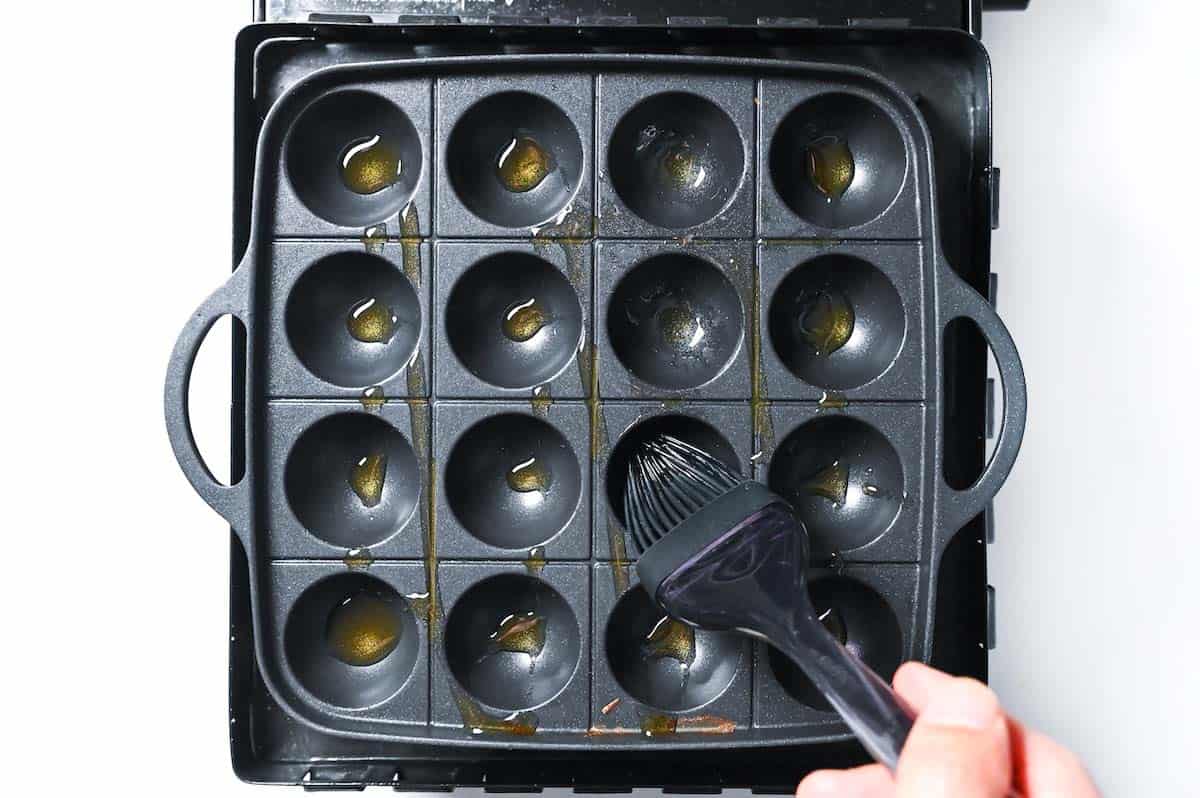
Pour the batter over the molds, filling each one about halfway. Don’t worry if some batter goes outside of the mold, it will all be rolled into the takoyaki later.
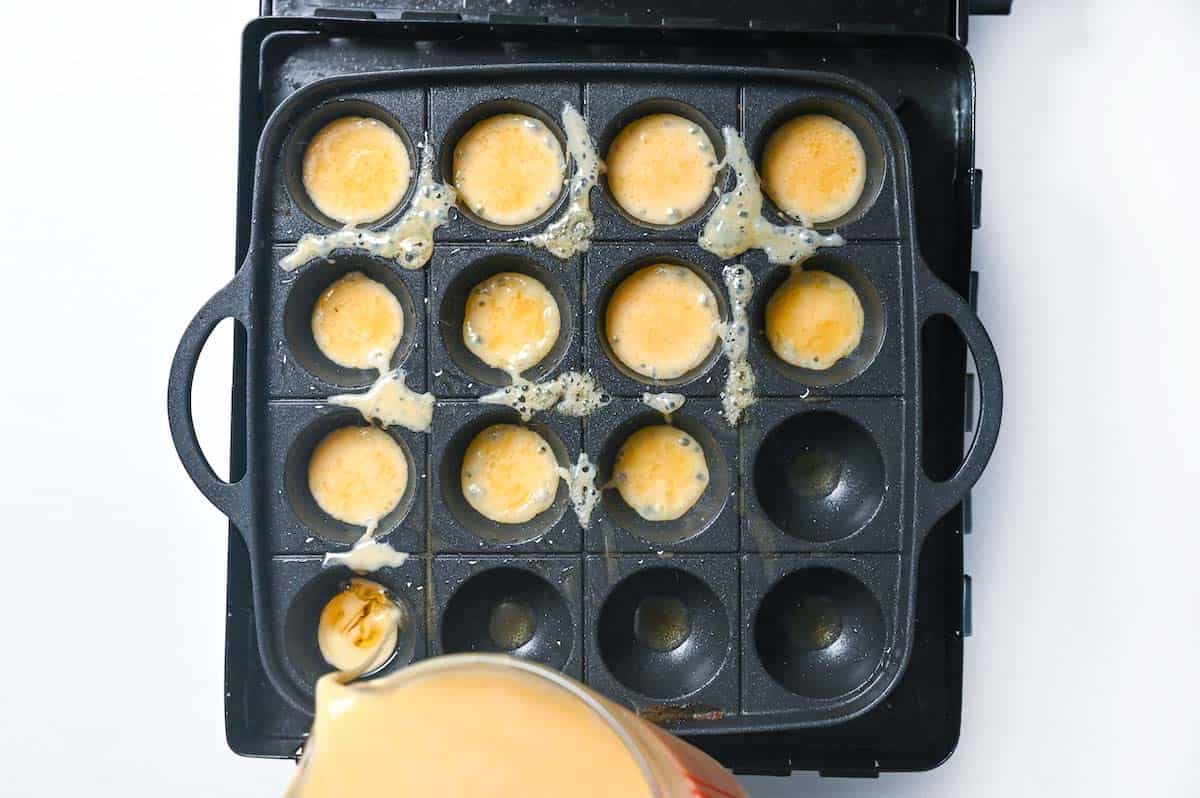
Place a piece of octopus in each mold.
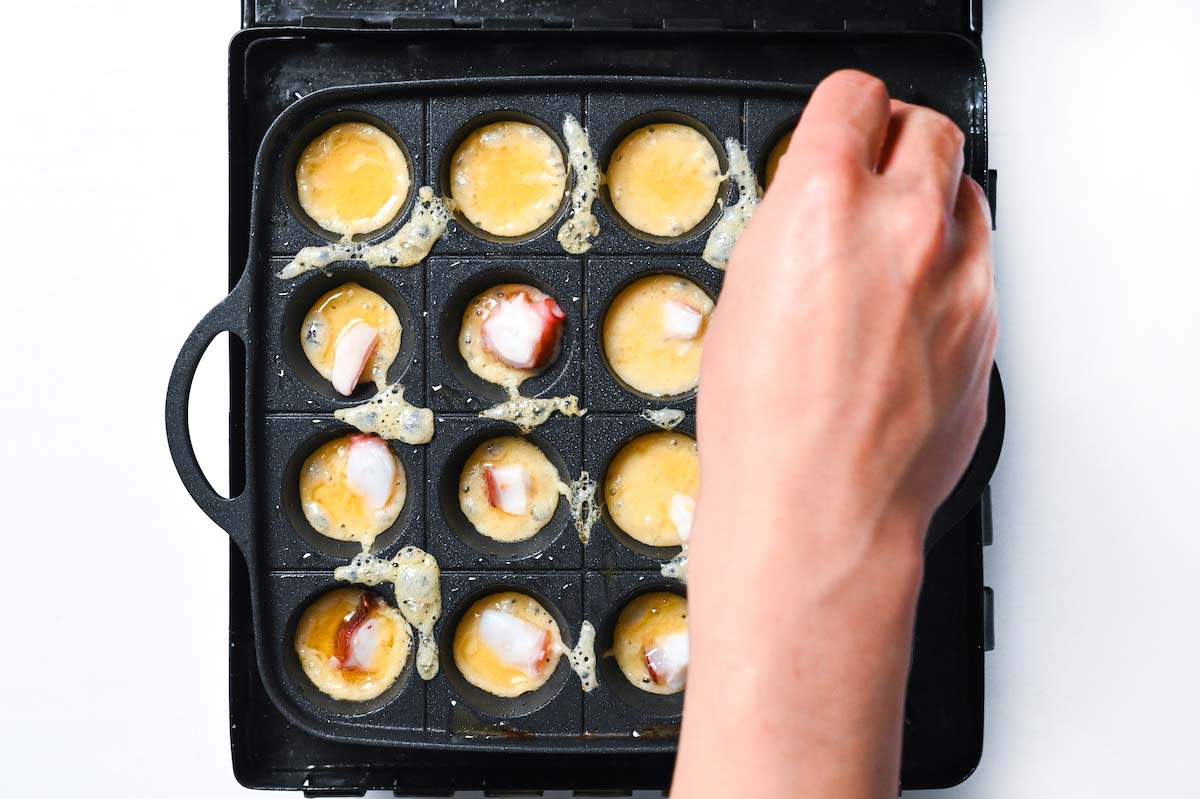
Pour more batter over the top so that the surface is completely covered, even the surface around the edges.
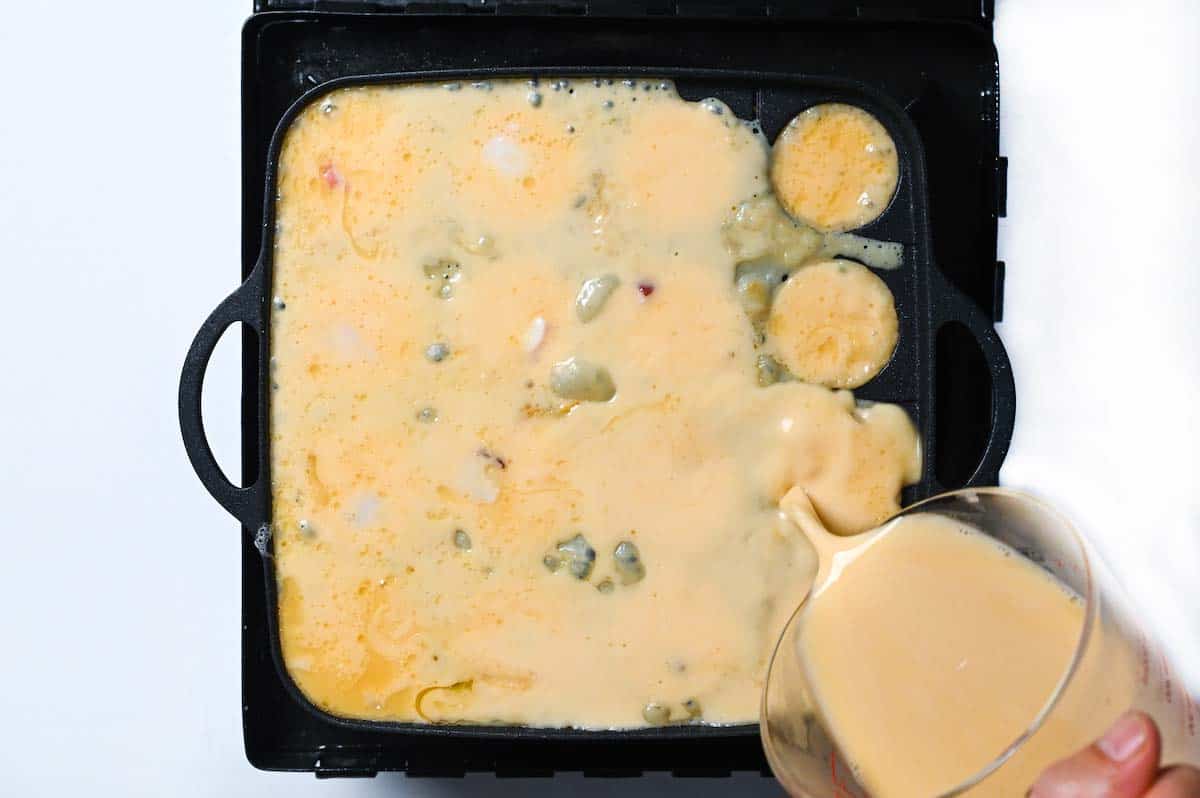
Then sprinkle the tenkasu (tempura bits) evenly over the surface.
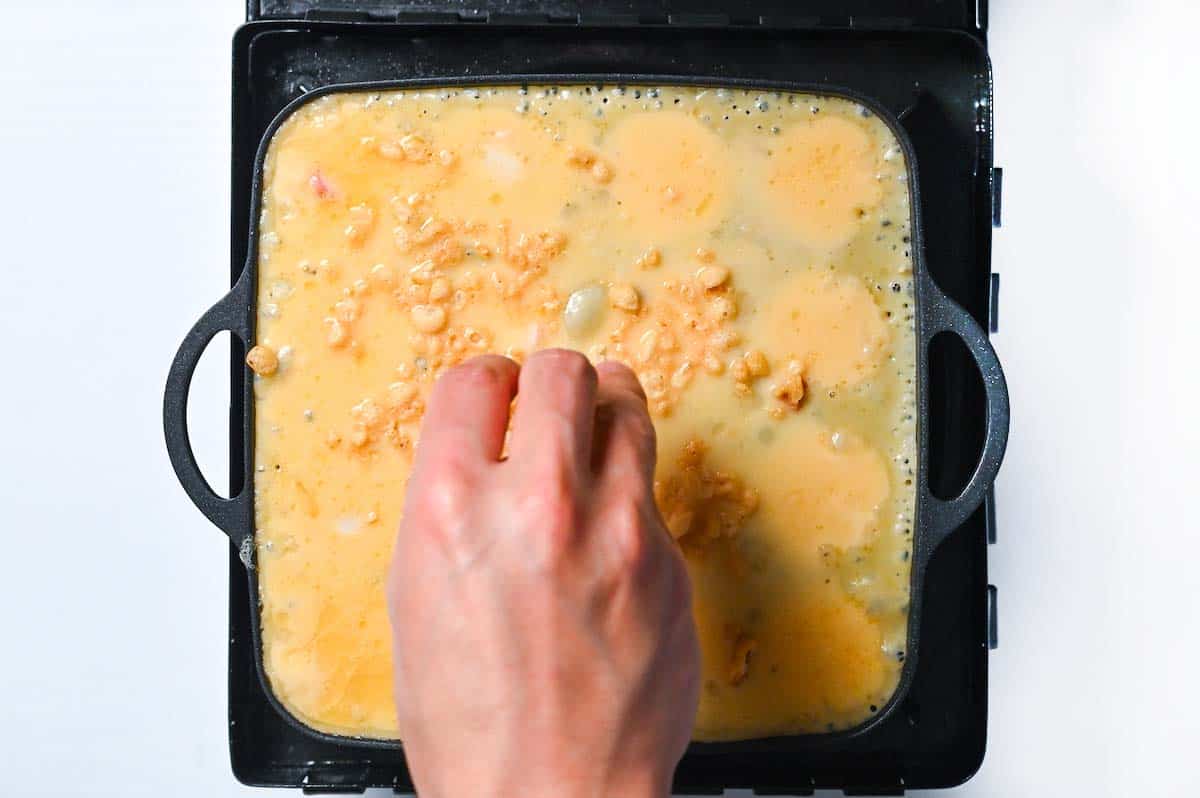
Followed by the benishoga and chopped spring onion.
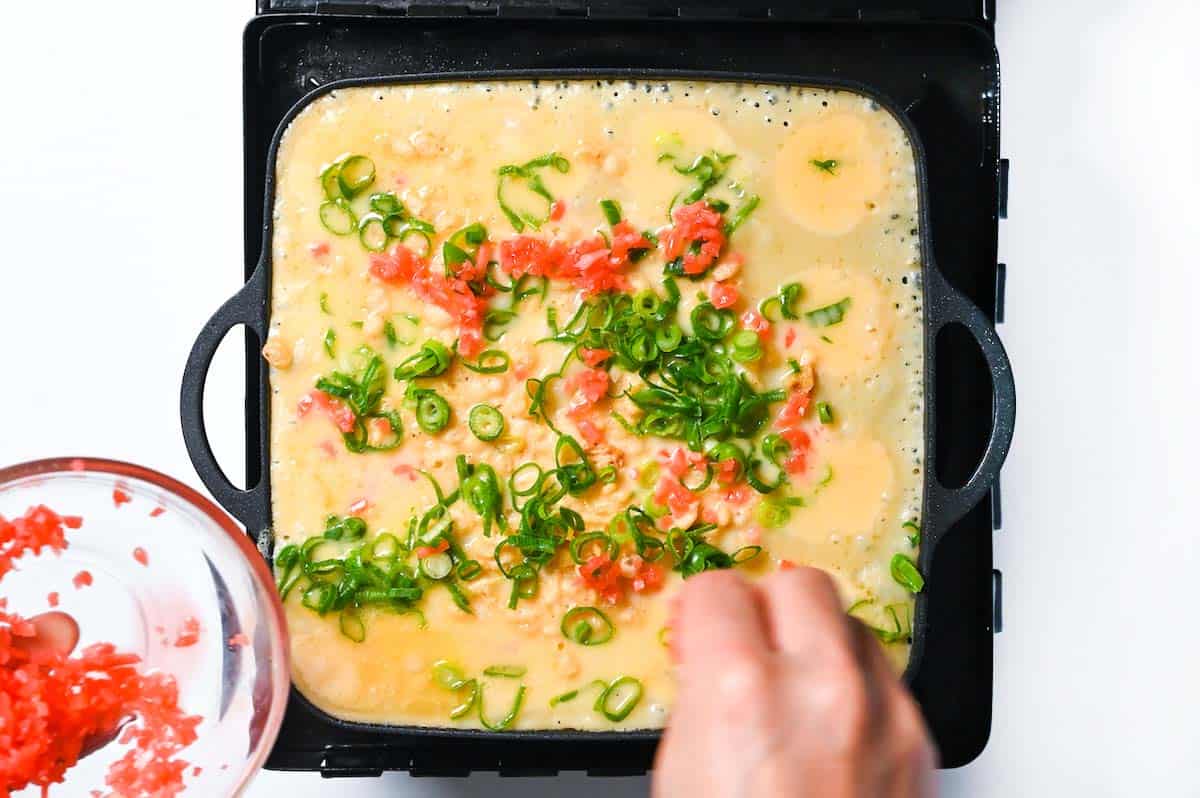
Once the batter starts to cook and firm up a little, use a bamboo skewer to draw lines between each mold to divide it into squares.
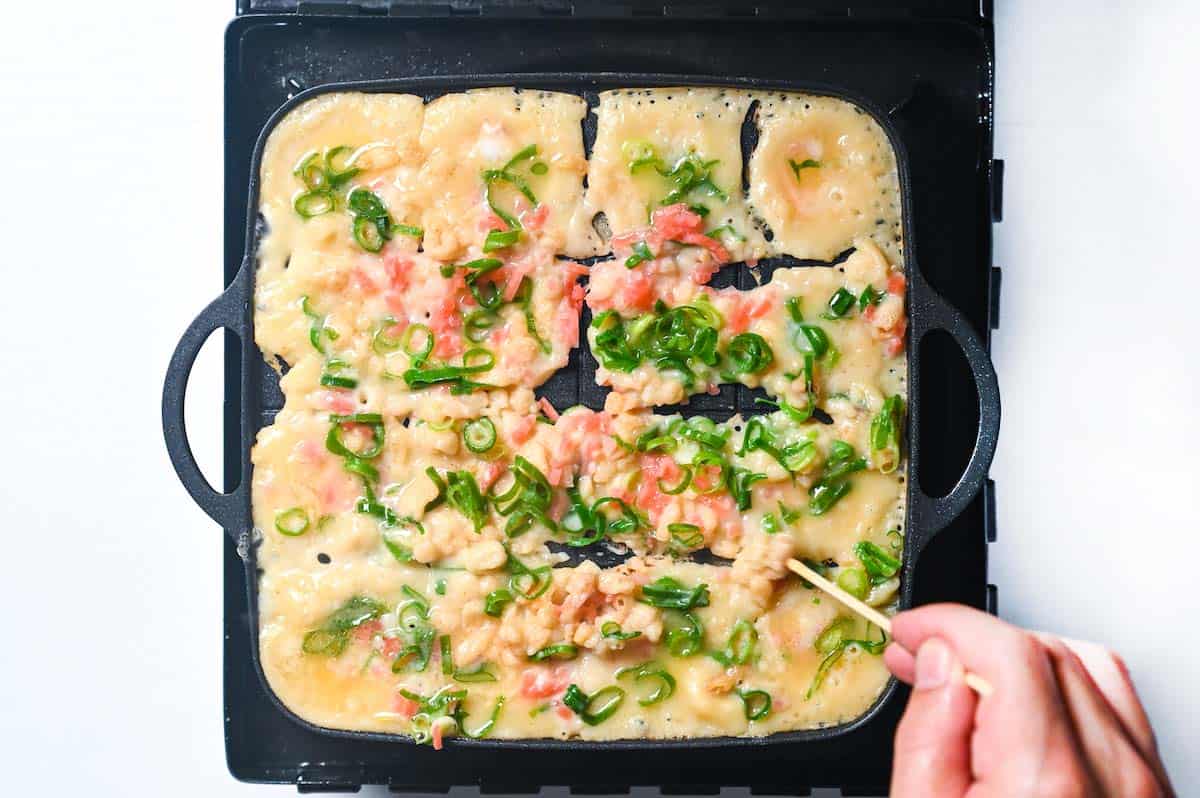
Use the skewer to scrape the edge of the slot in a circular motion to turn the takoyaki over about halfway. The reason we don’t turn it all the way is so that we can push the messy parts into the middle of the takoyaki.
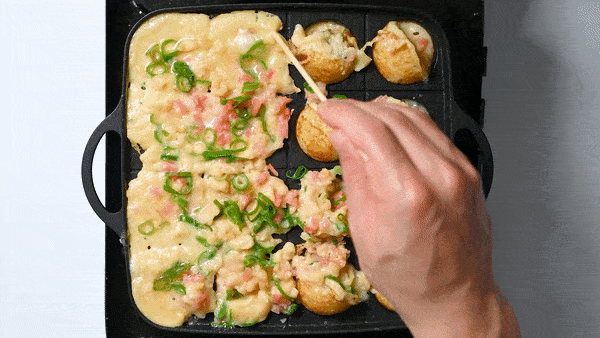
Leave it to cook for a few minutes. Once browned underneath, roll again to cook the bottom of the takoyaki and tuck any messy bits underneath. This will help make them perfectly round.
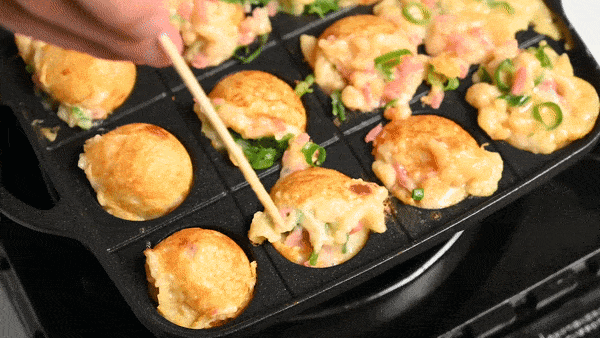
Once all the takoyaki are round, drizzle with another layer of sesame oil and continue turning them occasionally.
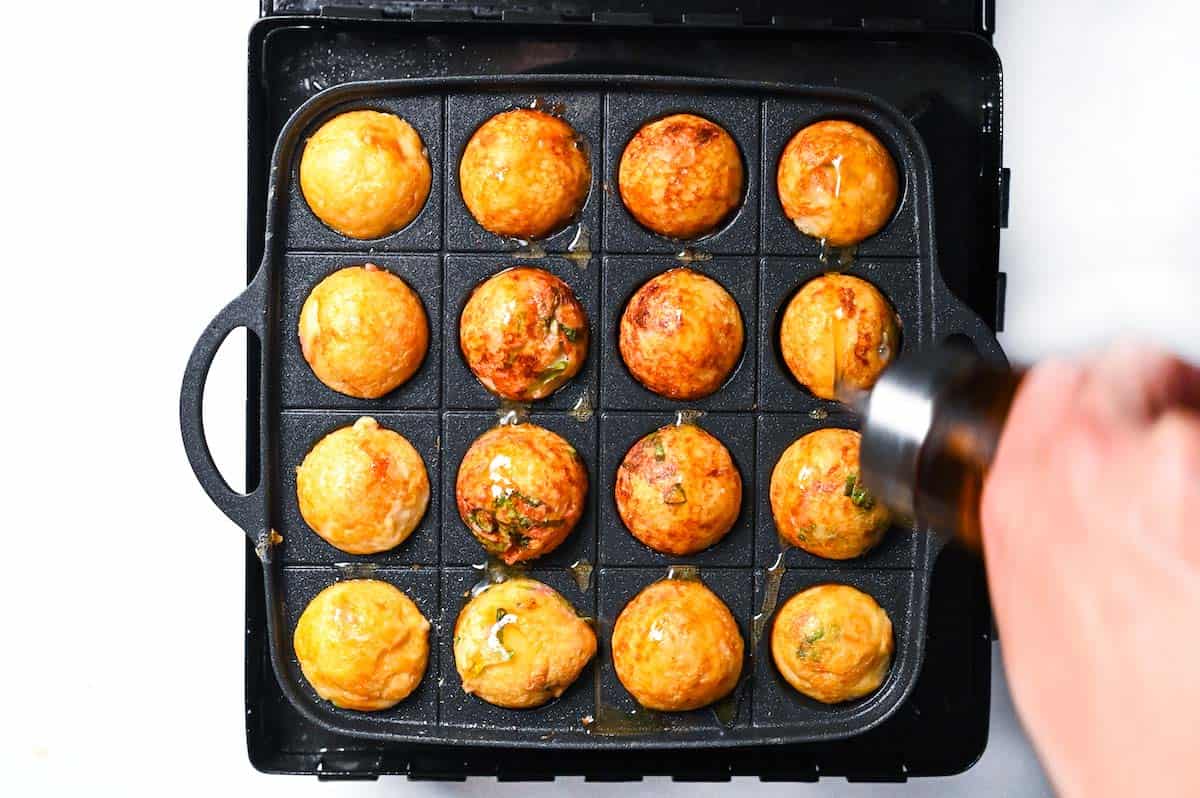
Turning the takoyaki will help them cook evenly all over.

If there appears to be some takoyaki that are paler than others, you might have heat spots. This is a common problem that is easily solved; simply swap the pale takoyaki with the darker ones. This will ensure all the takoyaki are evenly cooked and browned.

The completed takoyaki should be golden, lightly crispy on the outside, soft, and a little runny on the inside.
Once cooked, transfer the takoyaki to a serving plate and top with your choice of toppings. In this case I added the sauce, Japanese mayonnaise and chopped spring onion.
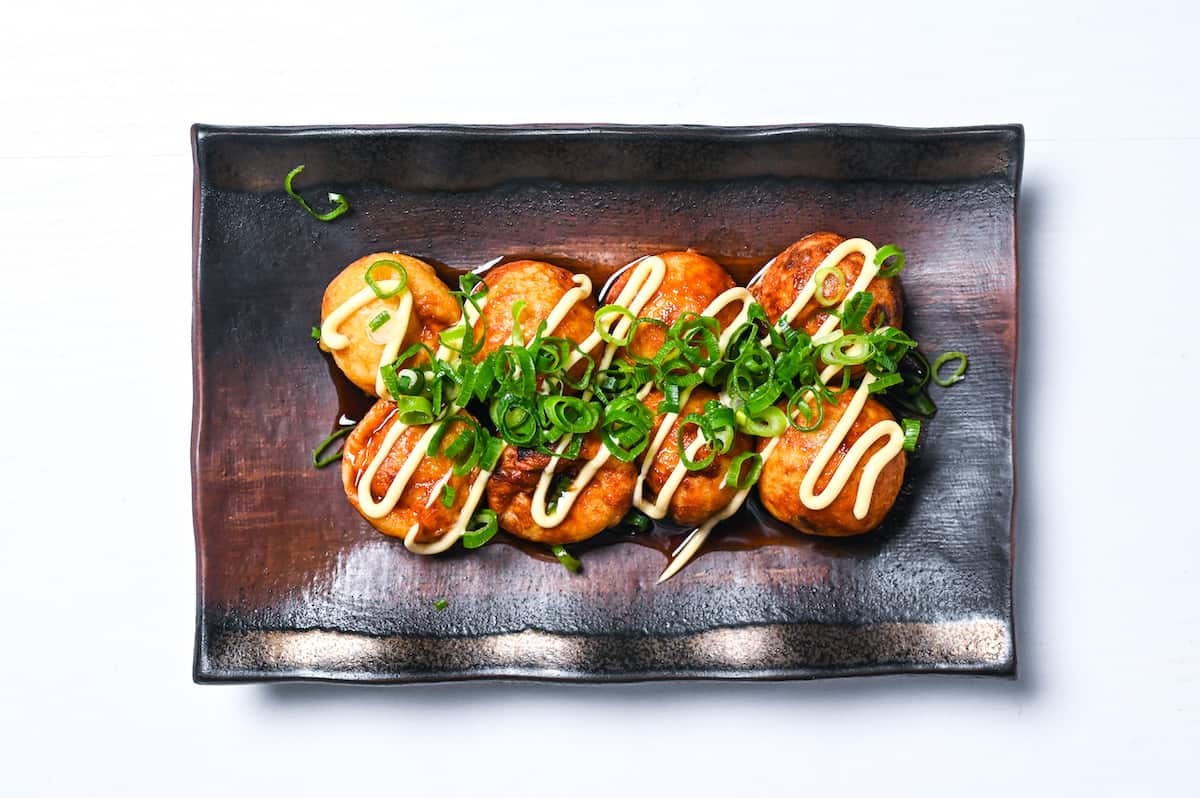
And enjoy your delicious homemade takoyaki that tastes like it’s straight from a Japanese street food stall!
Jump to Full Recipe MeasurementsTips & Tricks
- Overfill the mold – If you just fill each mold with a small amount of batter, you will find that either the takoyaki becomes quite small or they’re not round enough. You need to overfill it and then push the excess batter into the mold and turn it when it starts to cook and firm up.
- Use picks or bamboo skewers to turn them – It’s easy to use a pick to scoop around the edges and turn each takoyaki.
- Swap places – Usually, the heat isn’t 100% evenly spread across the takoyaki pan, even with high-quality ones. That’s why it’s good to occasionally swap the pale ones with golden ones to ensure they’re all evenly cooked.
How to Store
Of course, takoyaki is always best when it’s freshly cooked, so I don’t recommend making them in advance, but how about leftovers? Can they be stored? If so, for how long? How can I reheat them? I will answer all these questions here!
Storing
Takoyaki can be stored in the refrigerator for 1-2 days. Store without sauce and toppings and add them after reheating for best results. (See more about reheating below!)
Takoyaki can also be frozen and has recently become a popular freezer food in Japan. Allow them to cool completely when freezing and then place them on a tray spaced apart. Freeze for about 30 minutes and then transfer to a sealable freezer bag or container. This will stop them from sticking together. Takoyaki can be frozen for about 2 weeks.
Reheating
Whether chilled or frozen, it’s better to reheat takoyaki after storing. I recommend using an over or toaster oven, but air friers and even a frying pan will work. Avoid microwaving, as it makes them soggy and unevenly heated.
- Oven or toaster oven: Preheat to 350°F (175°C). Place takoyaki on a parchment-lined baking sheet and heat for 10-15 minutes until warm and crispy.
- Air fryer: Preheat to 350°F (175°C). Cook takoyaki in the basket for 5-8 minutes until heated and crisp.
- Pan-fry: Heat a nonstick skillet or takoyaki pan with a bit of oil. Cook takoyaki, turning occasionally, until heated and crisp.
Some people heat them in the microwave for a short time to heat the middle and then finish off in the oven or toaster to crisp up the outside. This is an option for frozen takoyaki, but I don’t recommend it for chilled.
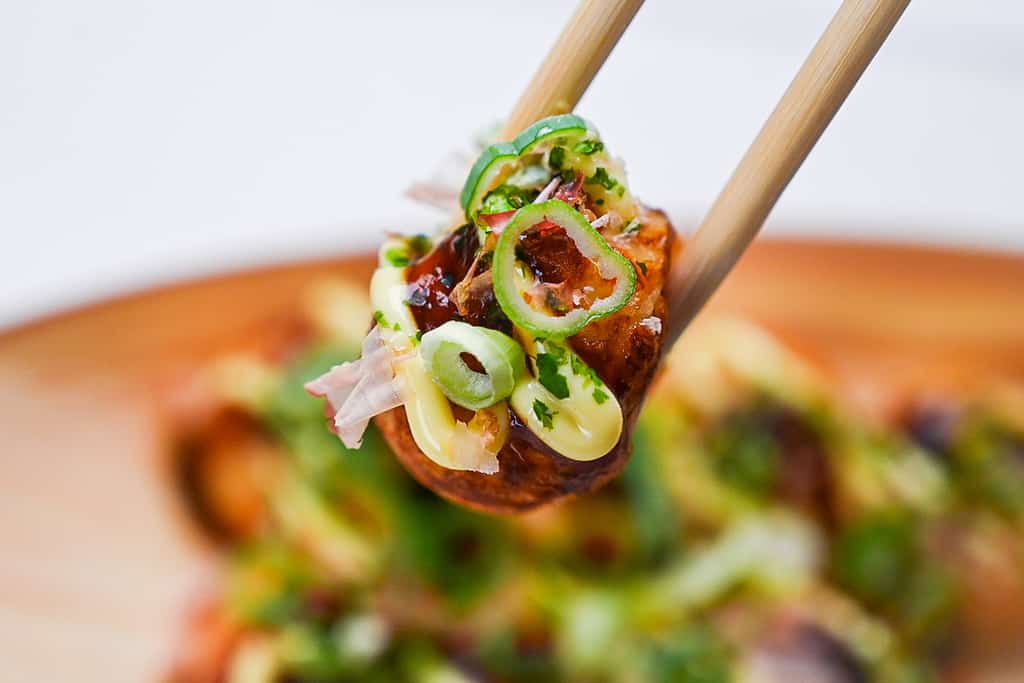
Flavor Variations
While takoyaki sauce, mayo, katsuobushi, and chopped spring onion are the most standard toppings, there are many more variations of toppings for takoyaki!
If you’ve ever been to a takoyaki shop in Japan, I’m sure you must have seen an extensive menu of more than just “sauce takoyaki.”
So here, I will share 8 ideas you can use at home to create takoyaki with a twist!
Soy Sauce (Shoyu Takoyaki)
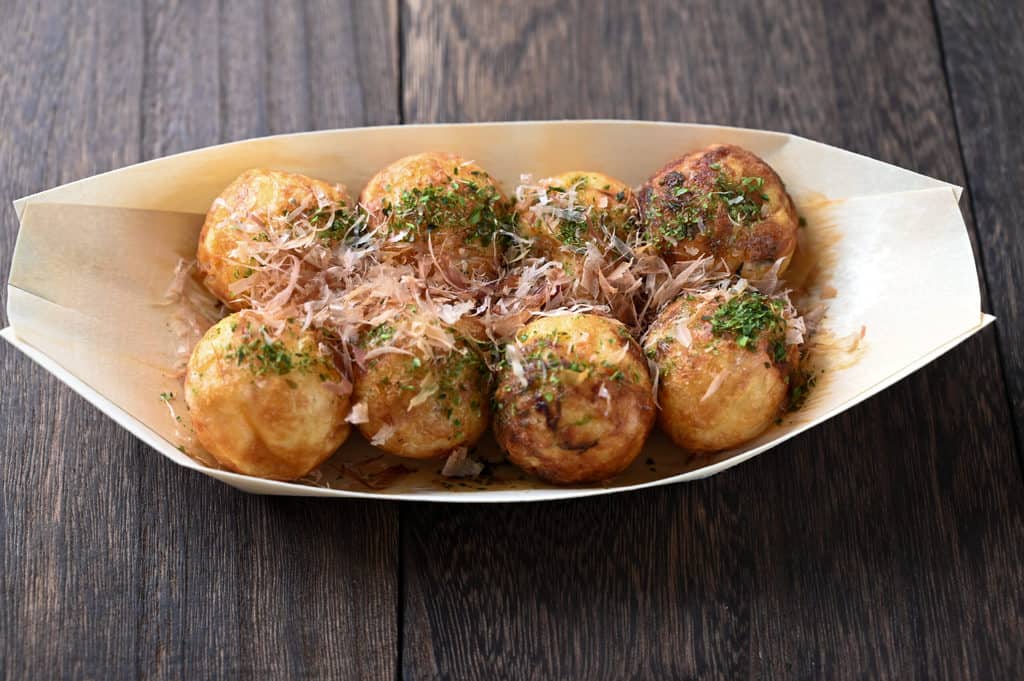
The biggest competitor against sauce takoyaki is soy sauce takoyaki! This old-school takoyaki shop is near my house, and they only serve sauce takoyaki and soy sauce takoyaki. That being said, this is a classic twist.
All you need to do is replace “takoyaki sauce” with soy sauce, but be careful with the amount, as adding soy sauce is much saltier.
- How to make it differently: Use soy sauce instead of takoyaki sauce. I also remove mayo and chopped spring onion for this
- Amount: 1 – 1 1/2 tsp per 8 balls
- Recommended: For a saltier flavor
Grated Daikon & Ponzu (a.k.a Negipon)
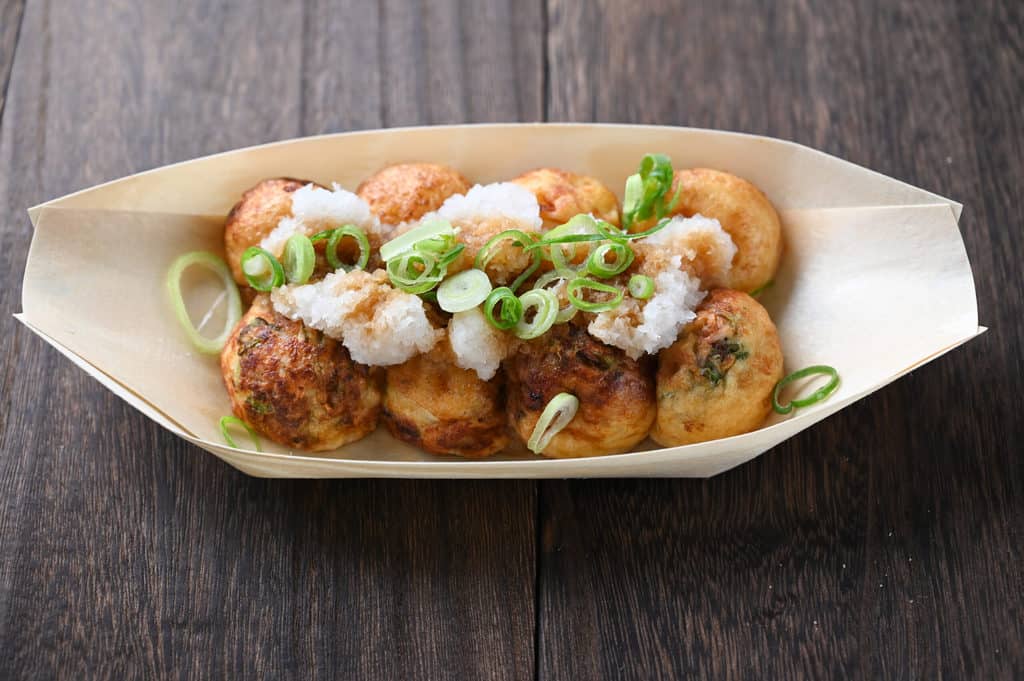
Refreshing flavor from a mountain of grated daikon and sourness from a citrus soy sauce called “ponzu”? This is another Japanese favorite! I love how takoyaki can be transformed into a refreshing dish like this!
It’s also known as “negipon” in Japan, and when something has a loveable nickname, it must be good right?
- How to make differently: Top with a large amount of grated daikon, ponzu, and chopped spring onion
- Amount: the desired amount of grated daikon, 1 tbsp ponzu, and 1 tbsp spring onion
- Recommended: For refreshing flavor
Ponzu & Shichimi Chili Powder
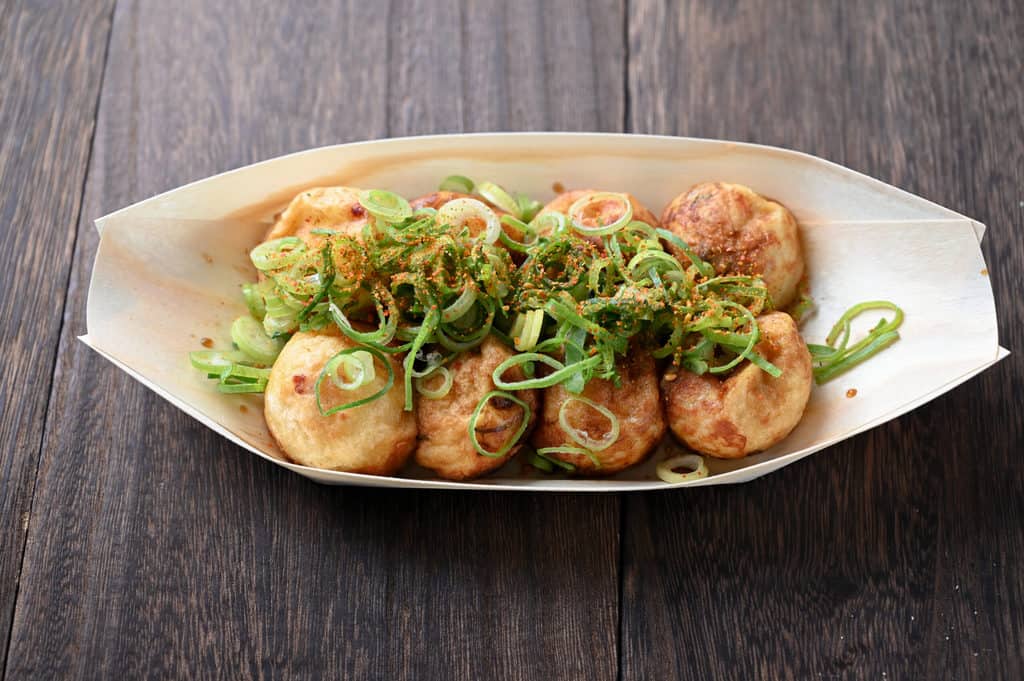
Do you like spicy flavor? Then, this can be the topping variation for you! The sourness of ponzu and the hint of spiciness from shichimi chili powder are a great combo!
- How to make differently: Top with ponzu, chopped spring onion, and shichimi chilli powder
- Amount: 1 tbsp ponzu, 1 tbsp spring onion, and 1/4 tsp shichimi chili powder
- Recommended: For some sour/spicy kick
Salt & Mayo
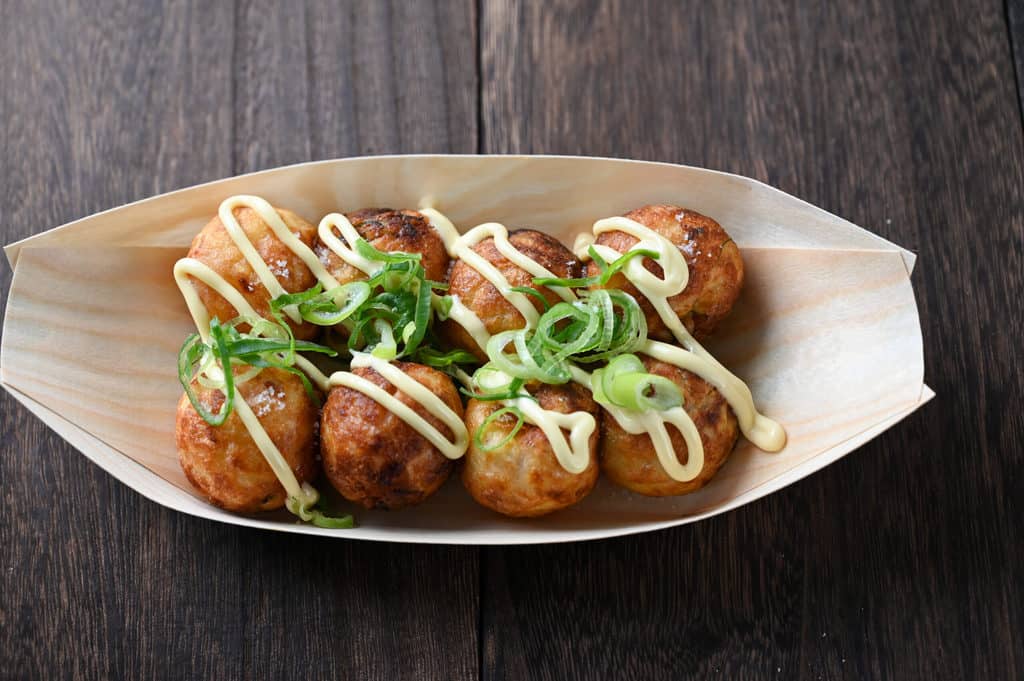
Whether you believe it or not, one trend in Japan is “salt takoyaki.” You can savor every bit of takoyaki balls by removing fancy flavorsome sauce.
While it seems like going backward, this is actually very, very good.
- How to make differently: Sprinkle with salt and drizzle with Japanese mayo, finish with chopped spring onion
- Amount: 2 pinches of salt, 1 tbsp mayo, and 1 tbsp spring onion
- Recommended: To enjoy more “authentic” taste of takoyaki
Pure Salt
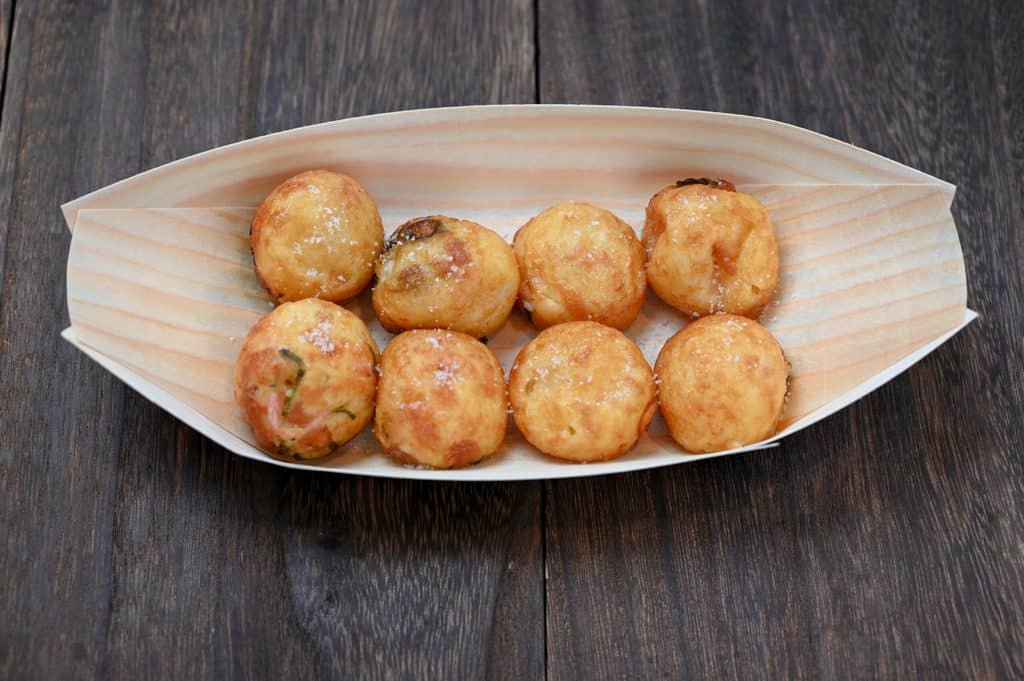
This one goes even further as it’s a pure takoyaki with pinches of salt. You might think it’s too boring, but this is the best way to enjoy deep dashi flavor!
- How to make differently: Sprinkle with salt
- Amount: 2 pinches
- Recommended: To enjoy takoyaki as it is to the fullest
Lemon Juice, Salt & Chopped Green Onions
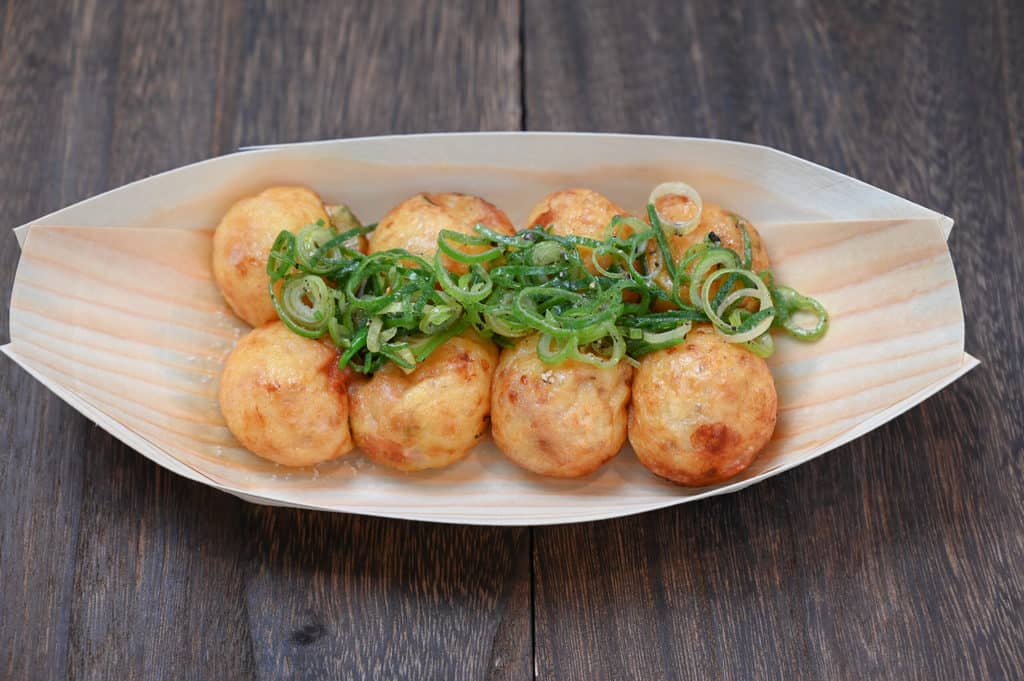
Looking for a refreshing kick in takoyaki? If so, this is a kind of takoyaki you should try! Simply pre-mix chopped spring onion, salt, and lemon juice, then put it on!
- How to make differently: Sprinkle with lemon juice, salt, spring onion mixture
- Amount: 1 tbsp chopped spring onion, pinch of salt, and 1/2 to 1 tsp lemon juice
- Recommended: To make takoyaki refreshing
Mentai Mayo
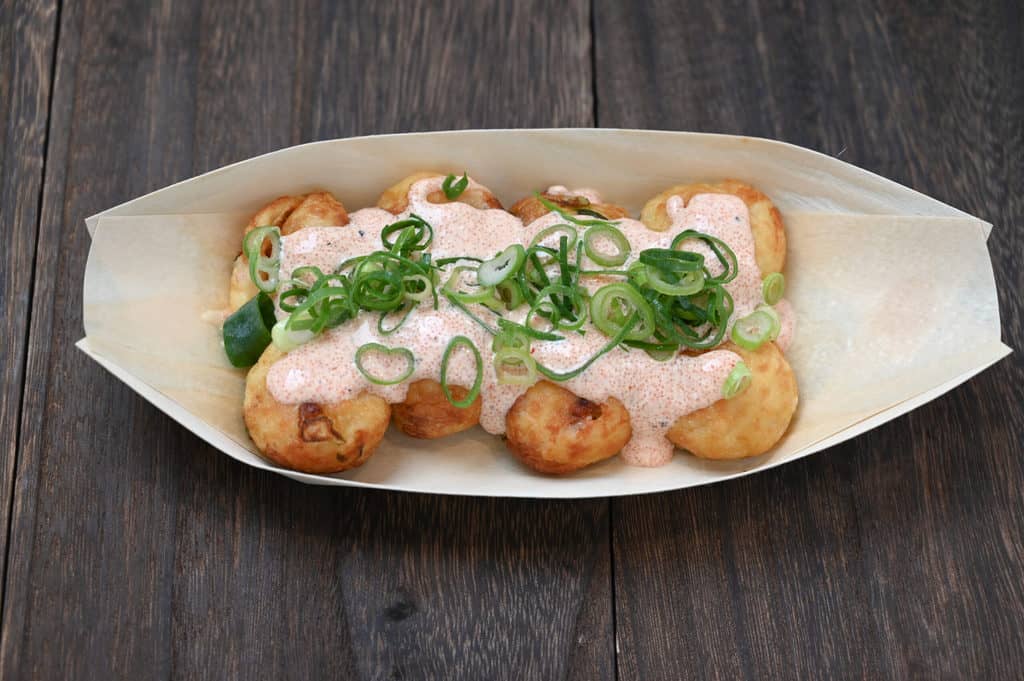
Wanna try something completely different?
This topping is made from a pickled spicy cod roe called “mentaiko” mixed with Japanese mayonnaise. You can often see this topping at some takoyaki stalls as well! It might not be for everyone, but if you like mentaiko, you’ll definitely love it!
- How to make differently: Add mentaiko and mayonnaise mixture topped with chopped spring onion
- Amount: 40g mentaiko and 2 tbsp mayonnaise (mix together) and sprinkle with 1 tbsp chopped spring onion
- Recommended: To try something completely different
With Dashi Tsuyu
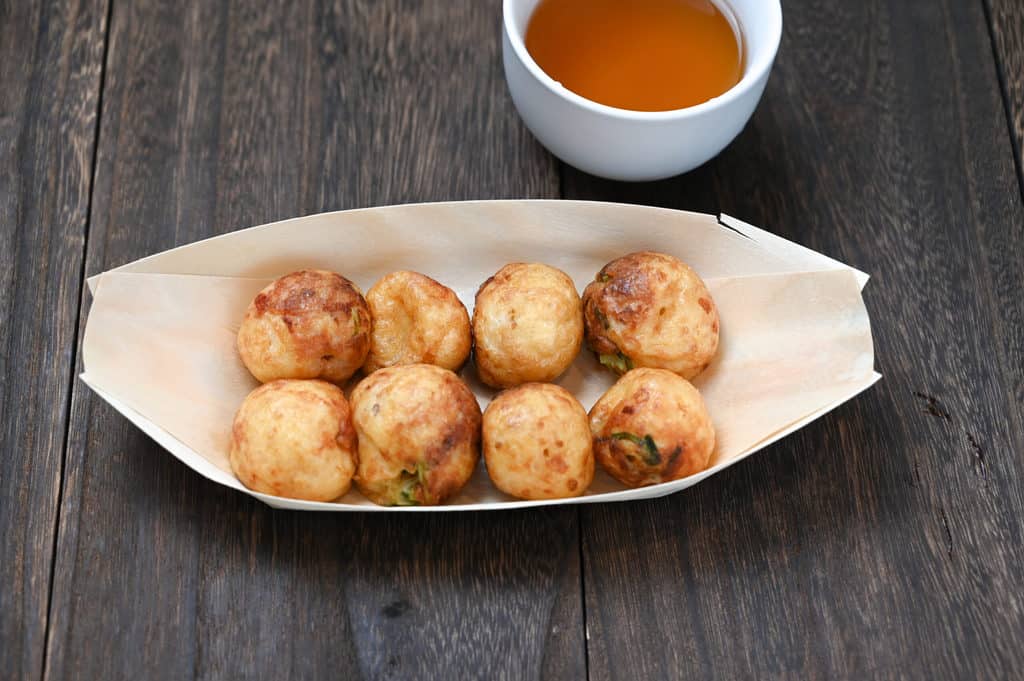
This is surely something different from the others as it’s takoyaki with dipping sauce! It’s a homage to takoyaki’s descendant “akashiyaki” and you can experience something different.
For dashi tsuyu, you can simply use the same sauce as kake udon soup or premade tsuyu sauce mixed with water.
- How to make differently: Prepare dashi tsuyu and dip takoyaki
- Amount: 100ml dashi tsuyu (if you want to make it from scratch, you can refer to kake udon recipe)
- Recommended: To try something completely different
I hope you enjoy this Takoyaki recipe! If you try it out, I’d really appreciate it if you could spare a moment to let me know what you thought by giving a review and star rating in the comments below. It’s also helpful to share any adjustments you made to the recipe with our other readers. Thank you!
More Japanese Street Food Recipes
- Yakisoba (Japanese Stir-fried Noodles)
- Hiroshima Style Okonomiyaki (in a frying pan)
- Osaka Style Okonomiyaki (Japanese Savory Pancake)
- Chicken Karaage (Crispy Japanese Fried Chicken)
Check out my Street Food Recipe Roundup post for more Japanese street food ideas!
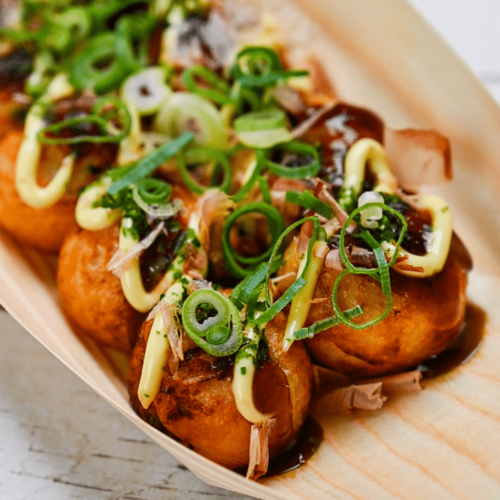
Japanese Fried Octopus Balls (Takoyaki)
Ingredients
Sauce
- 1 ½ tbsp Worcestershire sauce
- ½ tbsp tsuyu sauce (noodle soup base) or soy sauce
- ½ tbsp tomato ketchup
- 1 tbsp honey
Batter
- 500 ml dashi stock cooled
- 1 egg
- 100 g cake flour
- 1 tsp tsuyu sauce (noodle soup base) or soy sauce
- toasted sesame oil for cooking
Fillings
- 120 g boiled octopus see post/note for alternatives
- 4 tbsp red pickled ginger (benishoga)
- 50 g finely chopped green onions
- 30 g tempura flakes (tenkasu)
Toppings (add according to preference)
- Japanese mayonnaise
- aonori (dried green seaweed powder)
- bonito flakes (katsuobushi)
- finely chopped green onions
My recommended brands of ingredients and seasonings can be found in my Japanese pantry guide.
Can’t find certain Japanese ingredients? See my substitution guide here.
Instructions
- First, make the sauce by adding the 1 ½ tbsp Worcestershire sauce, ½ tbsp tsuyu sauce (noodle soup base), ½ tbsp tomato ketchup and 1 tbsp honey to a small bowl and mix thoroughly. Set aside for later.

- Next, take a mixing bowl, pour in the 500 ml dashi stock and 1 tsp tsuyu sauce (noodle soup base). Crack 1 egg into the bowl and whisk until combined.

- Add 100 g cake flour to a separate bowl and make a well in the center. Pour the dashi mixture into the well while whisking until it forms a smooth batter.

- Cut 120 g boiled octopus into small pieces (approx 1 inch / 2.5cm) and finely chop 4 tbsp red pickled ginger (benishoga) and 50 g finely chopped green onions.

- Heat up the takoyaki pan and generously coat the mold with toasted sesame oil. Brush the oil into each crevice until evenly coated. (If you don't have a brush, spread the oil using kitchen paper.)

- Once the takoyaki pan is hot (almost smoking), pour the batter into the mold, filling the crevices half way.

- Place a piece of octopus in each slot and then pour more of the batter over the top, making sure the surface is completely covered, even the surrounding surface.

- Sprinkle the chopped green onion, chopped pickled ginger and 30 g tempura flakes (tenkasu) generously over the top of the wet batter and allow to cook for 1-2 minutes.

- Using a long bamboo skewer (or similar), draw lines between the slots to divide the batter around each takoyaki.

- Roll the takoyaki about half way by scraping the bamboo skewer around the edge of the slot in a circular motion with your wrist. It’s okay if the shape is still messy at this point. Leave to cook for a few minutes.

- Roll the takoyaki again, tucking any messy parts into the bottom to shape it nicely. After the second roll it should already be more or less round.

- Once the takoyaki is round enough, brush with another layer of sesame oil and keep rolling the takoyaki one by one.

- Swap any pale takoyaki with the more golden ones to ensure even cooking. (This is due to the inevitable heat spots on the pan, generally the ones in the middle directly over the heat source cook faster.)

- Once the outside looks golden and crisp, remove the takoyaki from the pan. (The middle is still usually a bit runny, this is normal and you don’t need to cook it until it’s firm all the way through.)

- Place the cooked takoyaki on a plate and brush the with the sauce from earlier. Drizzle with mayonnaise and sprinkle with your choice of toppings.

- Repeat until all the batter and ingredients are used up, and enjoy!
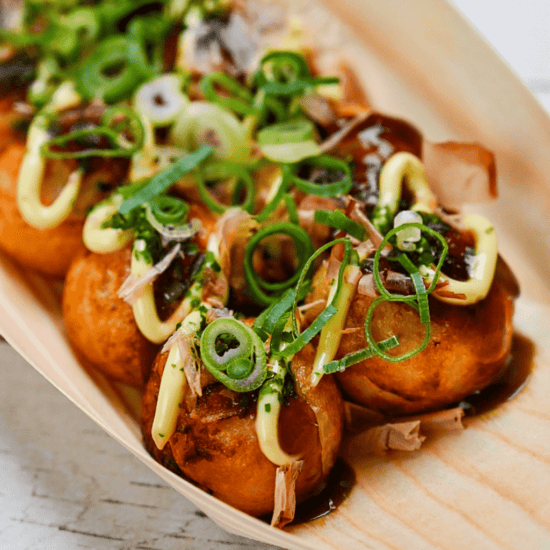




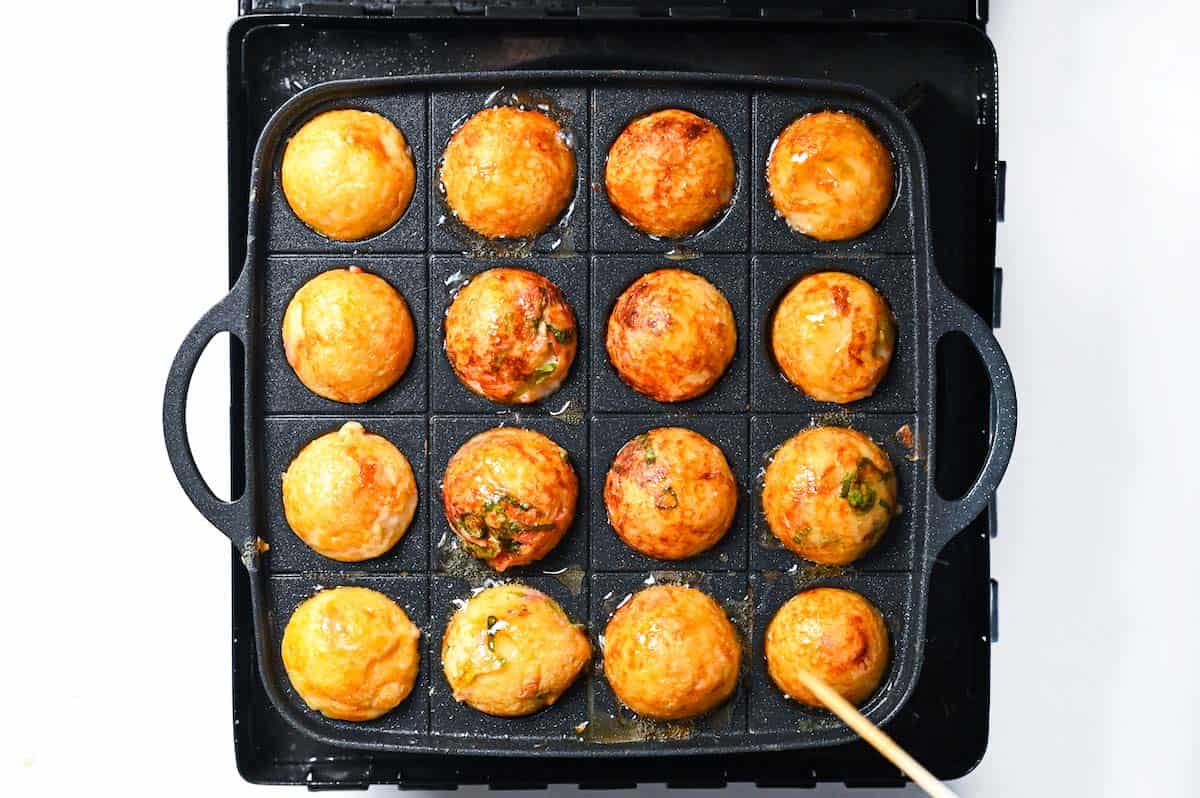
Hi everyone,
After reading the part about the takoyaki pan and its possible alternatives, I felt I needed to leave a comment on this article.
I am not familiar with the takoyaki pan or this Dutch Aebleskive pan. Why this pan is called Dutch aebleskive pan in English, I don’t know, because this is something Danish and I haven’t seen it in the stores here in the Netherlands.
Because I am Dutch, but here in the Netherlands we have another traditional dish called “poffertjes” – who are best described as miniature pancakes – and they are baked in a similar pan as the takoyaki pan. Therefore, takoyaki is always descriped as “savoury japanese poffertjes” here. Some TV cooks even mention that they can be made in a poffertjes pan.
But by the looks of it, a takoyaki pan is not entirly the same as a poffertjes pan. I have the impression that the wells of a poffertjes pan are a bit shallower. I have measured the wells and they are 2,4 cm in diameter and 1 cm deep, for references. Therefore I think that if you were to use these, you need to chop your filling a little bit smaller, but I haven’t been able to try it so far.
Hi Laura, thank you for your comment and bringing this to my attention. Actually aebleskiver are Danish and as you mention, poffertjes are Dutch. I remember reading about both when I was writing this article and must of gotten them mixed up. I’m sorry about that! I appreciate you pointing this out and I’ve updated the article.
I agree that poffertjes look smaller than aebleskiver and takoyaki, it might be difficult to make takoyaki in a poffertjes pan because the octopus would need to be cut very small. I’d love to hear if it works though, please let us know if you try it.
Hello Yuto and other curious readers,
Yesterday I tried making takoyaki in the poffertjes pan. Although I had to make it with cultivated mushrooms, as octopus is not easy available here. I wasn’t unhappy about the result, but it wasn’t picture worthy (most of them looked more like failed Kaiserschmarrn). But I think that had more to do with my own skills then that it doesn’t work.
I used my moms heavy traditional cast-iron pan that need to be put on a (gas) stove, as I do not have access to my own untill around christmas. The difference with my own is, that I have an electric waffle iron with excangable non-stick plates – including a poffertjes plate. This requires a bit different technique in the baking process.
As such, I had difficulties in estimating how much oil I need to use per well, meaning that some were more deepfried, whereas others did not want to release from the well.
I had taken into account that I need to cut the filling smaller, but I hadn’t taken it into account that a smaller well also means that the batter becomes faster solid. As a result, I didn’t add all the filling (mushroom and spring onion) fast enough. I.e. the filling didn’t go deep enough in the batter anymore.
Therefore I think next time, I would even cut the fillings smaller and mix them together before starting. This way I can take a “pinch” of the filling and hopefully add them all at once fast enough.
As for the turning them around, I did this as I would do for poffertjes, meaning they are only turned around once. I didn’t think that there would be any point trying to get them spherical, as a poffertje-well is mathematically roughly 1/75 of its sphere in volume, and therefore just the cap. The problem here is that I could not turn them around untill the batter wasn’t liquid anymore, but then the surface that was up before could not go properly in the well to get baked aswell.
Therefore I really would like to try to make the takoyaki in my own waffel/ poffertjes iron. Because here I would fill the well, and close it so it gets bottom and top heat at the same time. Beside this, the manifacturer recommends turning the machine upside down (the machine is designed that way) immediatly after closing, so that the batter can divide properly, and turning it staight later in the baking process.
Furthermore, the traditional poffertjes batter contains yeast and the non-traditional one bakingpowder, meaning it would rise during baking. In addition, the water/flower ratio is different and therefore easier to turn around when it is semi-liquid, allowing it to be more flexible and filling the well after turning it around.
As a result, it wasn’t really clear to me if the cakeflower you use contains baking powder or anything else to make it rise while baking. The recipe I have to make cakeflower is 82-87% flower, 10-15% starch (potato or corn) and 3% bakingpowder. This resulted in 3 gram baking powder.
I also have another question. As far as I can tell, tsuyu sauce is not available, and also the ingredients aren’t very easy to get here. The Asian cuisine here is heavely dominated by chineese and indonesian influences. As you were stating that tsuyu sauce is mainly soysauce with a taste of sweet and umami, I was wondering if tsuyu sause can be (sometimes) replaced – in your opinion – by ketchap manis, maybe with some extra mushroom. For now, I just used soysause (by the way, japanese soysause is available here and I know how to make ketjap manis myself, so I could leave out/ add things/ change ratio if I want to).
In addition, sake is more easy available then mirin, as making sushi is on the rise here. But from my “Aroma” book I didn’t get any wiser then that sake contains a higher alcohol percentage then mirin, but both taste great with fish. Therefore I was also wondering wheather or not they can be exchanged with each other.
To make a long story short, I am definitly going to try it again around christmas with my own waffel/ poffertjes iron. For comparison I will “tweak” the poffertjes batter to obtain takoyaki flavour, and see what happens (I like appologise to poffertjes/ takoyaki traditionalist before hand, but I just like an experiment). So, to be continued…
Hi Laura,
Thank you so much for sharing your results with us!
Takoyaki takes some practice to get a nice shape, I had to practice many times too.
To be honest, it’s better to use more oil so that it’s easier to turn. The outside also becomes crispy, it’s okay if it has a deep fried effect. (Although this is my personal preference.)
The poffertjes pan seems to be smaller than I thought, I think that adding the ingredients to the batter is a great idea in this case, seeing as it cooks too quickly to add it in later.
The cake flour I use doesn’t contain baking powder, the main reason to use cake flour is due to the low gluten content which makes the takoyaki lighter and a bit airy. We don’t really need it to rise because we turn it as it cooks. (Although, if it does rise a little, I don’t think it would cause problems. The eggs would add a little rise anyway.)
As for tsuyu sauce, this recipe only uses a little and I think soy sauce is a fine substitute. I’ve never used ketchap manis, but I do have a recipe for homemade tsuyu sauce here > https://sudachirecipes.com/multipurpose-tsuyu-sauce/
This recipe doesn’t require sake or mirin (unless you decide to make your own tsuyu sauce.) Sake and Mirin are both kinds of rice “wine” but sake has a higher alcohol content and mirin is sweeter (a natural sweetness develops during the fermentation process.) They taste quite different and I wouldn’t suggest exchanging them with each other, many Japanese recipes use them both because they have different qualities.
Some people use a small amount of sake and then increase the sugar in place of mirin, this works for things like teriyaki sauce, but I haven’t tried it with tsuyu sauce. Hope this helps and I wish you all the best with your takoyaki making journey!